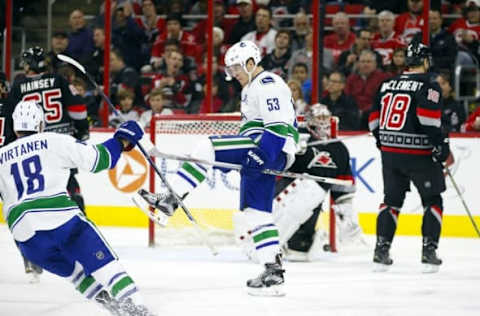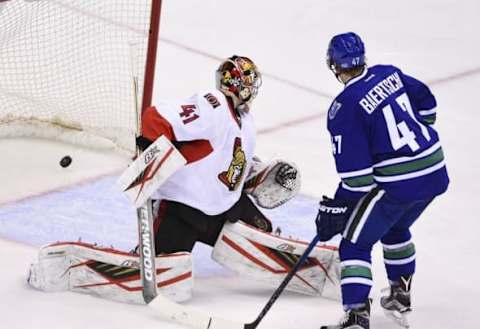Vancouver Canucks: 5 Players Who Could Score More Goals in 2016-17


The Vancouver Canucks need to score more goals in 2016-17. Here are five current players who could help.
This offseason, one of the most glaring questions for Vancouver Canucks general manager Jim Benning is, “who will score goals for the Canucks next season?”
The Vancouver Canucks finished second last in goals for in 2015-16. Their scoring struggles were best exemplified by some dark days in March where they set a franchise record for minutes played without a goal — which included being shut out in three straight games.
Goal-scoring is clearly a major area of weakness. Since Benning, Trevor Linden and Willie Desjardins all insist they want their team to challenge for the post-season in 2016-17, it’s a weakness that needs to undergo a major reversal.
A fifth-overall pick in the upcoming Entry Draft could land the Vancouver Canucks a major offensive talent, but it’s unlikely that player will be ready to step in and make a major impact this coming season.
Few of the available free agents are true top-six scoring wingers, and high demand will drive up the price to acquire them.
Short of an improbable free-agent signing, a coup at the draft, or a blockbuster trade, the Vancouver Canucks may be stuck with what they have.
So, what exactly do they have?
Could Help Come Within?
Daniel Sedin led the team in 2015-16 with 28 goals; Henrik Sedin contributed 11 of his own. Assuming the Sedins (particularly Henrik) stay healthy, 25 goals from Daniel and 10-15 from Henrik seem likely.
Jannik Hansen surprised many with a 22-goal year while playing first-line minutes with the twins. If he stays on that line next season, perhaps he can come close to that number again. He has scored 16 goals on two previous occasions.
So the top line shouldn’t score any less than it did last season — but it likely can’t score any more. Is there anyone on the current Canucks roster who could contribute more goals than they did last year?
Here a five such players. Included with each is a potential number of goals. This number is not so much a hard projection as a “best-case scenario”: how many goals could fans reasonably expect, if the player plays 82 games next season and if they perform to the best of their offensive ability?
Next: Number 1: Bo Horvat

Bo Horvat
2015-16 Points: 16 goals, 40 points in 82 games.
2016-17 Potential Goal Total: 25
It would be easy to say that Bo Horvat endured the proverbial “sophomore slump” for a large portion of last season; but that glosses over how much was asked of him during the year.
In the wake of the injury to Brandon Sutter, Willie Desjardins no longer had the option of managing Horvat’s deployment or workload. The Canucks needed a scoring center for the second line, and a third-line/shutdown center who could take a bulk of defensive zone draws. Horvat was forced to fill both roles as well as he could.
According to war-on-ice.com, Bo Horvat took 718 faceoffs in his own zone — more than Henrik Sedin, Jared McCann and Brandon Sutter combined.
The good news for the Canucks is that Horvat eventually figured out a way to score even while starting most of his shifts nowhere near the opposition goal. 75% of Horvat’s 40 points (14 G, 16 A) came after January 1st. Had he scored at that rate throughout the season, he would have finished with 26 goals and 55 points.
What Horvat needs in order to score more goals:
More offensive-zone starts. To squeeze more goals out of Horvat in the coming season, coach Willie Desjardins needs to deliberately do the reverse of what he was forced to do last season. Instead of deploying Horvat for the majority of defensive-zone faceoffs, the coach needs to start reserving Horvat for faceoffs in enemy territory.
The Sedin line remains the coach’s best option for offense; after that, Bo Horvat’s line is a clear second choice. If Horvat can score 40 points in a defensive role, surely he can score more if the Canucks use him primarily for offense?
A Healthy Brandon Sutter anchoring the third line. Willie Desjardins surprised everyone when he deployed Brandon Sutter as a winger on the Sedin line for the first few games of the season. Eventually, though, Sutter was moved into the second-line center role as had been anticipated.
Related: Horvat’s Sophomore Slump No Cause for Concern
But here’s the catch: in that role, Brandon Sutter scored nine points in 20 games when healthy. If he had scored at this rate through 82 games, he would have finished with 38 points — fewer than Horvat achieved while playing in a much tougher role than Sutter was given.
Clearly, Bo Horvat has far more offensive potential than Brandon Sutter; the coaches need to treat the two accordingly. Give Sutter the checking, defensive, shutdown role on the third line, and set up Bo Horvat to succeed offensively.
Bottom Line: Bo Horvat needs to be unleashed.
Getting more offense from Bo Horvat mostly comes down to deployment. As long as Brandon Sutter stays healthy and relieves Horvat of the defensive burden he carried last season, Bo Horvat can be unleashed as an offensive threat.
The 2016-17 season will be Bo Horvat’s third year in the NHL. The Canucks still don’t know exactly how high his offensive ceiling is. This year is perfect time for them to find out.
Next: Number 2: Sven Baertschi

Sven Baertschi
2015-16 Points: 15 goals, 28 points in 69 games.
2016-17 Potential Goal Total: 19
The Vancouver Canucks have yet to re-sign Sven Baertschi, who becomes a restricted free agent on July 1st. But since Baertschi was fourth in goals for the Canucks this year, there is no reason to suspect it will not happen.
Baertschi started last season slowly, managing just three assists in the month of October, while averaging 10.8 minutes of ice-time. He then started to warm up, chipping in five goals and eight points from November to December. He also saw his ice-time increase by an extra shift to 11.2 minutes.
When the calendar changed Baertschi continued to gain steam, notching 60 percent of his total production for the season — 10 goals, 17 points — after January 1st. With his increased production Baertschi also saw a dramatic increase in ice-time, averaging 15.6 minutes a game to finish the year.
Sven Baertschi began last season as a wild card, and ended it as a fixture on the second line and a permanent wingman to Bo Horvat. If Baertschi can continue the pace he set for himself to begin the 2016 calendar year, he could see another career year in goals.
What Baertschi needs in order to score more goals:
Stay the course. Sven Baertschi is a reclamation project who became a Jim Benning success story. The GM should re-sign him, and Baertschi likely deserves a multi-year deal.
The key for Baertschi then becomes to keep the same level of urgency on his new deal that he had with his one-year deal.
Sven Baertschi has never lacked for talent, but it was hard work that ultimately made him an NHL fixture and a scoring threat. He needs to continue to work hard in order to be effective.
Stick with Horvat. Willie Desjardins tried hard early last season to make Bo Horvat and Radim Vrbata a pair. In the end it was Horvat and Baertschi who had all the chemistry.
Related: Should Sven Baertschi Be Re-Signed?
Baertschi will almost certainly start the year back on Horvat’s line; his job is to play consistently enough to stay there. If the coach deploys Horvat as has already been suggested, Baertschi should get plenty of opportunity to challenge for 20 goals.
Bottom Line: Sven Baertschi needs to stay the course.
There were a lot of questions about Baertschi coming into the 2015-16 season, and for the most part, he answered all of them.
His next task is to prove that he was not a flash-in-the-pan. Last season needs to be a stepping stone toward something more.
Baertschi and the Canucks would both be well-served if he can play in October 2016 the same way he was playing in January. Baertschi was given three months to find himself last season, but he will not have that luxury again.
If he and Bo Horvat can stick together and keep their magic going, fans and coaches alike would be grateful.
Next: Number 3: Jake Virtanen

Jake Virtanen
2015-16 Points: 7 goals, 13 points in 55 games.
2016-17 Potential Goal Total: 15
Jake Virtanen was not eligible for the AHL last season, so management was faced with a decision — send him back to junior after nine games, or keep him with the Canucks for the entire season.
Virtanen impressed Vancouver Canucks brass enough that they chose the latter.
His abilities are not in question — Jake is strong and fast, and has good hands. What drew criticism was his inconsistency. There were short bursts when Virtanen was a game-changer for the Canucks, interspersed with periods where he was at best, invisible, at worst, a liability.
Even his teammates voiced this opinion during the season: Virtanen wasn’t expected to be the goal-scoring saviour; he just needed to show up and contribute every day.
The good news for fans is that, despite some inconsistency, Jake Virtanen scored 7 goals in the NHL as a 19-year-old. The even better news is that, like Horvat and Baertschi, he became more prominent on the scoresheet in the back half of the year, scoring six of his seven goals after January 1st.
What Virtanen will need to get there:
Stay out of the doghouse. You can’t score if you don’t play; and Jake Virtanen won’t play if coach Willie Desjardins feels he cannot trust the young Virtanen to play a complete pro game.
For Virtanen, simple things like defensive-zone coverage, backchecking, and consistent efforts in practices and workouts are as much a key to offense as they are to maturing as a player.
Coach Desjardins is clearly willing to incorporate young players into his roster, but he also expects those young players to be contributing to the team’s success and not standing in the way. With a year of pro experience under his belt, there’s a chance Jake Virtanen can convince his coach to keep him in the line-up and expand his ice-time.
Persistence. The key to Virtanen’s success is his physical game.
The Canucks want Virtanen to take the body on opponents as often as he can (provided he stays within the rules!). They also believe that Virtanen will be most successful when he drives the front of the net.
Related: Analytics say Jake Virtanen is Carrying His Teammates
Both of those things require Virtanen to show some tenacity — standing in the face of opposing goaltenders is an invitation to get assaulted by NHL defensemen. When Virtanen enters a rough stretch where he is not enjoying offensive success, he must resist temptations to become a perimeter player.
Jake Virtanen is a power forward; if he wants to be an effective one at the NHL level, he has to take the physical punishment and keep coming back for more.
Bottom Line: Jake Virtanen needs to learn how to be a pro.
Jake Virtanen’s numbers from his first season were not eye-popping. But watching his game and digging into his numbers show that Virtanen had stretches where he was highly effective.
All Virtanen needs to do is learn how to be that effective more often.
Next: Number 4: Brandon Sutter

Brandon Sutter
2015-16 Points: 5 goals, 9 points in 20 games.
2016-17 Potential Goal Total: 14
I know, I know — when discussing Bo Horvat I kept insisting that Brandon Sutter’s offensive potential is limited and that he should be playing behind Horvat on the depth chart.
All that is still true, but while Brandon Sutter’s ceiling may be that of a third-line center, he has performed well in that role throughout his career.
If you’re watching the Stanley Cup Final, you may have heard the names”Sidney Crosby” and “Evgeni Malkin” crop up. They just happen to be the two all-star centermen that played in front of Sutter while he was a member of the Pittsburgh Penguins.
Despite not being a focal point of the Penguins’ offence, Sutter never failed to crack 10 goals in a season while with that club. His worst season with Pens in terms of scoring pace was 2013-14, when he scored 13 goals in a full season while averaging 15.7 minutes a game.
15 minutes is likely what he will average if he plays on Willie Desjardins’ third line, so 14 goals seems like a realistic total for Sutter even if Bo Horvat surpasses him on the depth chart.
What Sutter needs to get there:
Stay healthy. It’s hard to imagine Brandon Sutter’s first season in Vancouver being any worse than it was. On a team that had several unlucky injuries (hello Dan Hamhuis), Sutter’s luck was the worst. Half the battle will be staying in the lineup; if he can do that, he should be a contributor for the Canucks.
Embrace third-line role. When Sutter was brought into Vancouver, Jim Benning clearly envisioned him playing on second line. While Sutter’s numbers all point to him being nothing more than a third-line center, paying him $4.5 Million to fill that role is not that outrageous.
More from Canucks News
- Canucks are in “wash, rinse, repeat” mode after Monday’s 5-1 loss
- Canucks send Jack Rathbone and Vasily Podkolzin down to Abbotsford
- Canucks acquire Ethan Bear, Lane Pederson from Carolina
- Brock Boeser, Curtis Lazar placed on injury reserve
- Canucks officially unveil Reverse Retro jersey in latest aesthetic change
Bo Horvat is still on his entry-level deal, as is Markus Granlund; Henrik Sedin’s $7 Million deal expires in two seasons. That adds up to roughly $13.5 Million for four centers. Compare that to, say, the Los Angeles Kings or the Chicago Blackhawks, both of whom are paying their top center $10 Million by himself.
Brandon Sutter can be an excellent third-line center, and his salary should not preclude him from playing lower on the depth chart. There’s no reason he cannot play on the third line and still produce.
Stable linemates. Once his role is defined, the next step is finding Sutter some players to play with on a nightly basis. Jake Virtanen might be a fit, as could any of Anton Rodin, Alexandre Burrows, or Jannik Hansen.
Bottom Line: Brandon Sutter doesn’t need to play above his head to produce.
A center lineup of Henrik, Horvat, Sutter, and Granlund — in that order — does not look half-bad, and the Vancouver Canucks have plenty of options to fill in case of injury, such as Brendan Gaunce.
There is no need for the Canucks to outsmart themselves with their centers; everyone can play in a role they are already comfortable in and the team will get more reliable production than they did last season.
Next: Number 5: Anton Rodin
Anton Rodin
2015-16 Points: 16 goals, 37 points in 33 games (with Brynas IF Gavle, Swedish Hockey League)
2016-17 Potential Goal Total: 13
Unlike everyone else on the list, Anton Rodin is a wild card. He was productive in the Swedish league during the past season and won the Swedish League MVP award;but we have no NHL numbers to set precedence for next season.
However, Rodin is very similar to Sven Baertschi. Both struggled to crack the NHL after being drafted in the early rounds (13th overall in 2011 for Baertschi; 53rd overall in 2009 for Rodin). Both are getting a second chance in Vancouver under coach Willie Desjardins. Both are left-handed shooters. Both are 5-foot-11 (Baertschi is 190 pounds; Rodin is slighter at 181).
So Sven Baertschi’s 15 goals and 29 points this season provides a good high-water mark for Rodin. Baertschi did not find his game immediately, and Anton Rodin will inevitably need some time to adjust to the North American game and carve out his place in the lineup.
If he can adjust properly, perhaps Jim Benning will have uncovered Sven Baertschi 2.0.
What Rodin needs to do to get there:
Find some chemistry. Could Rodin, like Baertschi, find chemistry with Bo Horvat? Could he bump Baertschi to his off-wing on the second line, or perhaps free Baertschi up to play elsewhere in the lineup?
Could he ride shotgun with the Sedins, as other lefties have before?
Could he line up beside Brandon Sutter, who can offset Rodin’s smaller size while Rodin helps him out offensively? Could Jake Virtanen and Rodin make a good pair of wingers for any of the Canucks’ centers for that reason?
The possibilities are intriguing, and Rodin could very well give the Canucks some good scoring balance throughout their lineup. We’ll have to wait for training camp to see how it all plays out.
Keep the coach happy. Like Jake Virtanen and other younger players, Rodin will need to make sure he is pulling his weight on defense if he wants to stick with the Canucks.
Willie Desjardins can sour on players if they are inconsistent, but at the same time, he showed Alex Burrows and Bo Horvat a lot of loyalty last season when they were not scoring, specifically because they were putting in good efforts on the other side of the puck.
It will probably take Rodin a while to find his offensive game; in order to buy himself time to do that, he needs to avoid being a healthy scratch. That means doing those “little things” that endear players to their coach.
Bottom Line: Anton Rodin needs to follow Sven Baertschi’s example.
They may not be identical players, and Rodin will not necessarily duplicate anything that Sven Baertschi has done.
But at the very least, Rodin should find some inspiration in seeing that, like him, Baertschi was given an opportunity with this club and this coach, was played in an offensively-inclined role that he could succeed in, and was given suitable rewards for what he made of that opportunity.
If Sven Baertschi could do it, Anton Rodin should not doubt that he could do it too.
Conclusion: The Vancouver Canucks may find extra scoring in-house.
The potential totals are optimistic, and not every player will get there. Some of these five might get injured or might just not play well enough.
But there is potential for some Vancouver Canucks players who are already on the roster for next season (except for Baertschi, who is expected to be retained) to bump the team up the scoring ladder.
Next: Vancouver Canucks Could Trade for the 3rd Overall Pick
I’ve projected that these players could net the team a total of 43 extra goals — I did use the word optimistic, now, didn’t I? That might be wishful thinking, but even if only one or two of these players reach these benchmarks it would be an improvement.
Either way, if a playoff berth is the goal, the Canucks need to score more, and the five players listed here could have a lot more to give.